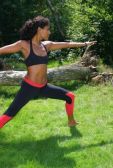
By Felicity Walker
Several of the most effective poses are the standing positions. They provide superior stretching of the muscles and they have recognizable effects on the speed and efficiency of the nervous system. Most standing poses manage to enhance the asanas and they offer you an increased opportunity of mastering equilibrium, both physical and mental. In the following paragraphs we will take a look at two of the most significant standing poses, the Mountain pose and the Triangle pose.
The mountain pose (known as the Tadasana) got its name from a number of defining properties that share the symbols of the mountain. The pose benefits from a high level of relaxed strength and a sense of invulnerability. Very like a mountain, the person practicing this pose will be surrounded by tranquillity and will feel a heightened impression of balance. The clarity and profound vision offered by this pose permit you to go deeper in your inner emotions and unite with your inner self on a very deep level.
The mountain pose is achieved by placing the heels slightly apart, so that toes are parallel. Carry out a back and forth rocking movement on your toes and slowly come to a complete stop. Raise the ankles in order to consolidate the pose while also tightening the leg muscles. Thrust your tailbone towards the floor while lifting your pelvic area towards the navel. Your arms should be resting near your body while you are pushing your shoulder blades backwards.
The clear-cut positive effects of the mountain pose made it the basis of many other poses.
Tadasana implies that the practicing yogi has to discover the meaning of balance and stillness before progressing further. For this reason, the mountain pose is one of the best ways to connect with your inner emotions while uncovering the subtle ways of yoga. The energy channels of the mountain pose traverse your whole body, following the spine, from the back of the neck and on towards the legs.
The next significant standing pose is the Triangle pose, or the Trikonasana. This comparatively easy pose has a satisfactory stretching effect on the spine, giving it a good lateral motion that complements the stretching of alternate forward poses. The straightness of the knees is essential while performing this pose, as this will allow your movements to be fluent and to stretch all the targeted muscles and organs.
Bending to the left and right needs to be done gradually and fluently. This is one of the yoga poses that is good for providing the foundation for the next levels of postures, which are more advanced and harder to perform. The stimulation of the spinal nerves is also useful and it improves complete body flexibility.
In order to enjoy the full advantage of the triangle pose you have to position your body properly. Your feet have to be spread apart while you are pointing to your toes. Try to alternate the pointing motion from your left foot to your right one while keeping a constant rhythm and perfect balance.
After you extend your arms parallel to the floor you should breathe in deeply, allowing the energy to reinforce your movements. While exhaling aim to execute a slight bend to either left or right while sliding your hand down your foot.
This motion requires a lot of flexibility in the lower back muscles area, so a good warm up session is completely essential before attempting the triangle. Yogis who try this pose often notice the sensation of a lighter body, joined with a feeling of mild warmth in the stretched muscles.




No comments:
Post a Comment